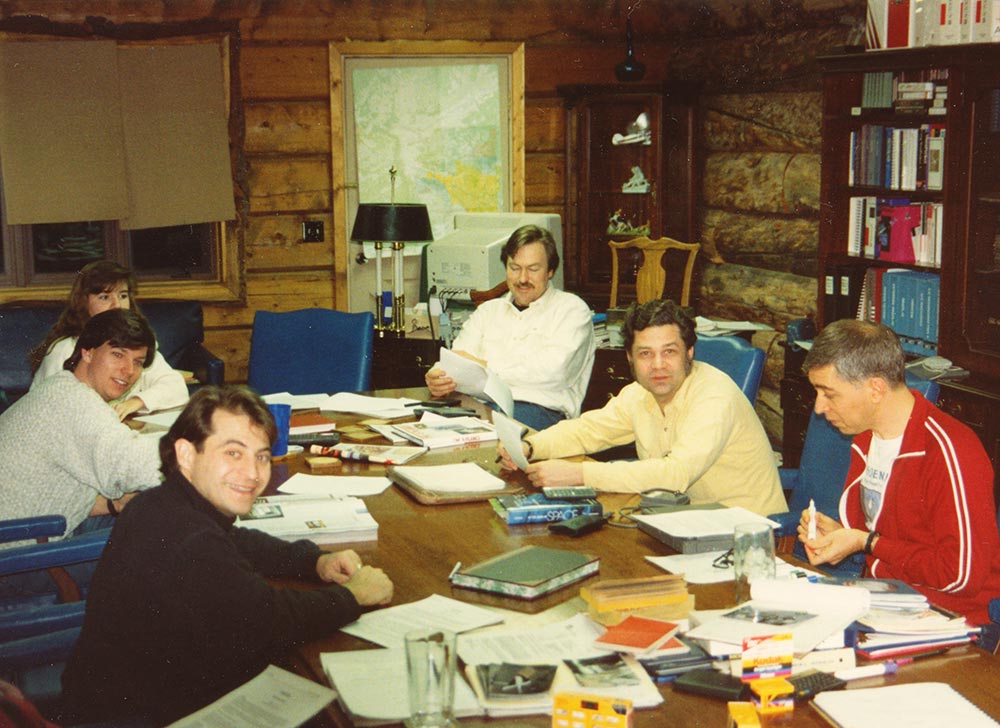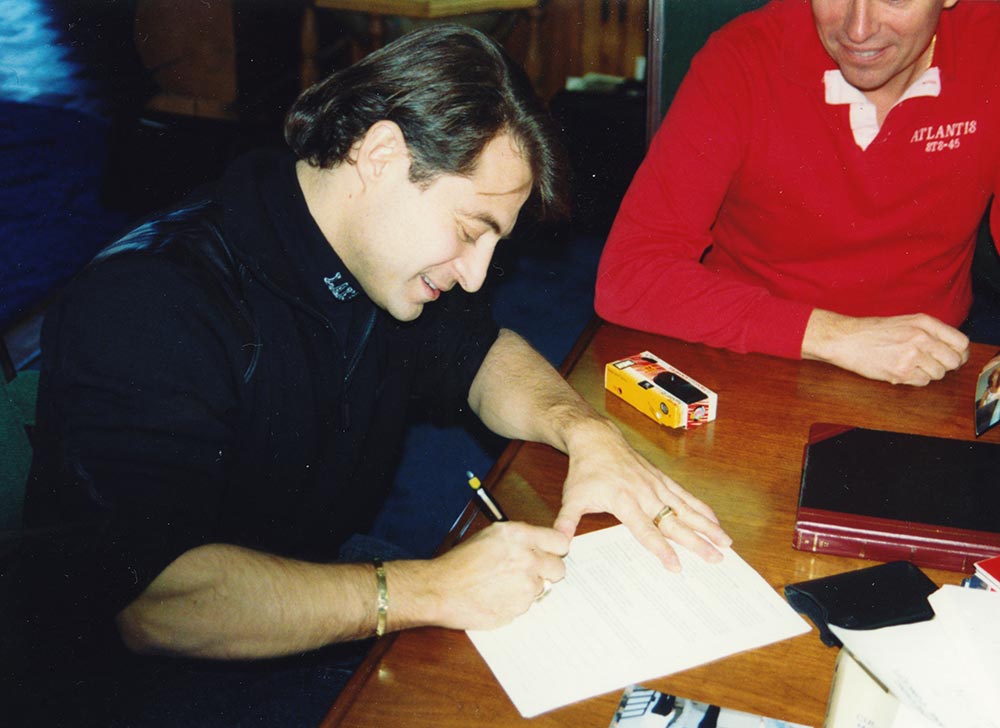This is adapted from a new book, How to Make a Spaceship: A Band of Renegades, An Epic Race, and the Birth of Private Spaceflight, by Julian Guthrie (Penguin Press, Sept. 20, 2016), with a foreword by Richard Branson and an afterword by Stephen Hawking. The book tells the story of Peter Diamandis, the $10 million XPRIZE and the private race to space.
Below is an excerpt from a chapter called “An Out-of-This-World Idea,” where Diamandis and other space lovers and aerospace engineers meet in Montrose, Colorado, to sketch out ideas for private space vehicles at a time when the commercial space industry did not exist. While Diamandis had months earlier thought of the idea of using an incentive prize to jumpstart a private space industry, this is when and where the idea took hold.
Related: 21 Life-Truths From the Man Behind XPRIZE
Peter girded himself in his seat as the small turboprop plane rattled and jolted its way from Stapleton Airport in Denver to the town of Montrose about an hour away. The wind gusted at 35 miles per hour, and visibility was less than five miles. A thick mixture of fog and snow churned in the darkness on the other side of the plane’s cold windows. Peter had organized a three-night, four-day “build a rocket” brainstorming retreat for rocket scientists and space lovers at a friend’s private home near Montrose in February 1994. The log “cabin” where they were meeting had 16,000 square feet, eight bedrooms, 7.5 baths, an indoor pool, and meeting rooms with high ceilings, arched wooden beams, chandeliers and large stone fireplaces. The home was not far from Telluride and—more important—close to Ouray, Colorado, also known as “Galt’s Gulch,” the mystical and secluded valley of Atlas Shrugged, where John Galt and the “men of the mind” went on strike to safeguard rational self-interest.
The goal of the Montrose gathering was to see whether a dozen men and women meeting over a weekend could hatch a new breed of rocket, finding inspiration in the improbable beginnings of many great companies: Harley-Davidson, Walt Disney, Hewlett-Packard, Apple and Microsoft were conceived in garages or sheds. Likewise, engineers and pilots, not governments, had started the aviation industry. A space lover named Jeff Bezos was reportedly starting a book company from his house to capitalize on the next big thing—the Internet.
As the shaky turboprop made its descent into Montrose, Peter tried to ignore the turbulence and focus on the meeting ahead. His goal going into the weekend was nothing less than to come up with a new rocket design that would take paying passengers to space. But he had another idea, too, one he had been studying in stealth mode.
On day one of the meeting, the group gathered in the conference room. Peter, wearing black pants and a thick black turtleneck, wrote on the whiteboard: “SMALL TEAMS CAN DO BIG THINGS.”

COURTESY OF PETER DIAMANDIS
It was something he needed to believe in now more than ever. Like a projectile veering off course, Peter had landed in unfamiliar terrain. He had managed to sell his beleaguered company, International Microspace to CTA of Rockville, Maryland, which designed and manufactured satellites and made software and hardware for ground-and space-based systems. Peter had scrambled to keep International Microspace one step ahead of bankruptcy, but he now found himself doing something he never wanted—climbing a corporate ladder as a mid-level executive at CTA. He was going on 33 and in a job that wasn’t for him. He needed to get back to his scrappy roots—of launching a national student space group, Students for the Exploration and Development of Space, starting a graduate-level space university, and designing, building, and testing out gravity-defying ideas in the Man Vehicle Lab at MIT.
The Montrose attendees began discussing how to build a new rocket for space travel. Peter scribbled a dozen formulas for propulsion options on the board and shared his sketch of a small space plane. The banter was animated and continued into the afternoon.
Hours later, Peter excused himself and slipped out of the room. He took the stairs to his room two at a time. Sitting down at his desk, with his view looking south to the snow-capped Ouray Mountains, he began to type:
CHARTER
“The John Galt”
There are few chances in one’s life to aspire to greatness. When such an opportunity comes along, the most difficult job is to recognize it, the second most difficult job is to take the risk of acting upon it. The project described in this Charter is one such opportunity. It cannot be ignored—it must be acted upon. All those who join The John Galt Team and sign the last page of this document recognize the challenge, the sacrifice, the fun and the need to accomplish this goal. Throughout all of history, the greatest accomplishments of the human race have been instigated and acted upon by the individual or the small group—never have the masses brought about innovation. We have the accomplishments of Charles Lindbergh and the Rutan/ Yeager Voyager team as our guiding stars, and every NASA program since Apollo as our incentive to bring about change.
Peter returned downstairs and took his place at the whiteboard. He envisioned both a prize and a rocket. He wrote, “PRIZES WORK.”

COURTESY OF PETER DIAMANDIS
“Prizes help to focus energy.” Peter told the group. “They provide a spirit of competition which has been one of the most important driving forces during the entire history of humanity.” The more he talked, the more animated he became. “Space needs prizes. Space needs a return to small, well-articulated goals. Goals which involve and excite the general public.”
Related: Competition Can Push You to Do Incredible Things
Peter handed out a paper he had drafted titled “Spaceflight Prize Strategy.” The copies were marked proprietary and confidential. The paper read in part:
There is a strong technology available which helps humans in achieving difficult, sometimes seemingly impossible feats. This technology is a forcing function which helps to focus the whole of human ingenuity at the same well-articulated goal.… This concept, the forcing function, this technology, is the competitive “Prize.” Not prizes for spelling bees or prizes for a lifetime achievement, but prizes which lay out impossible goals and tempt man to take great strides forward. Prizes such as those which were set out to the aeronautical world for speed, distance, endurance, etc. Prizes which brought forward adventurers, dreamers and doers. Prizes such as the $25,000 Orteig Prize (for the first aviator to fly nonstop across the Atlantic from New York to Paris or Paris to New York). Where no government filled the need and no immediate profit could fill the bill, the Orteig Prize stimulated multiple different attempts. Where $25,000 was offered, nearly $400,000 was spent to win the prize—because it was there to be won.
Peter wanted to do for space what Orteig—through the young and daring aviator Charles Lindbergh—did for aviation. He now had everyone’s attention. He wanted to galvanize a path to space the way Lindbergh opened the door for commercial air travel.
He completed the mission statement, the rationale for the project and the timeline. Above the signature lines, he included a list of required reading to give members of the team a current base of experience and an understanding of similar successful undertakings in the past. Peter’s required reading list included Atlas Shrugged; The Spirit of St. Louis; Voyager, by Dick Rutan and Jeana Yeager; and The Man Who Sold the Moon, by Robert Heinlein.
Since childhood, Peter had continued to move inexorably toward space, in the same way Cézanne kept painting the same apples; his latest idea for his canvas of space was his most ambitious yet. Peter left Montrose suffused with the feeling of certainty and promise, the way he’d felt as a child when he watched Apollo 11.
Related: How to Live to 150


